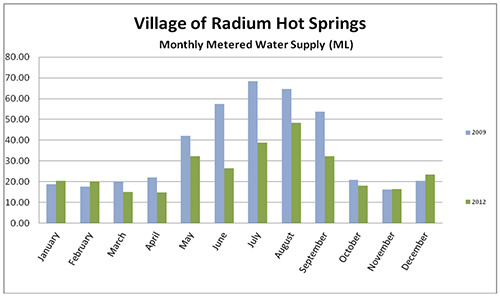Despite a higher rate of drinking water being used, Radium Hot Springs has made substantial upgrades over the past four years to save millions of litres of water.
“The Village of Radium Hot Springs has reduced gross community water consumption by 27 percent since 2009,” stated a July 9th press release issued by the village. “That is equivalent to 116 mega litres or 116,000,000 litres of water saved annually.”
Three reasons were cited as the top contributions towards the massive reduction: better management of municipal irrigation systems; village workers located and repaired leaking within the distribution system; and water utility staff were provided with specific training on water loss management.
Radium Hot Springs is a part of the Columbia Basin Water Smart Initiative, which provides support to participating regional districts, municipalities and First Nations to assess and address their local water conservation needs, and plan for the most locally effective actions to reduce community wide water consumption, according to the website.
One benefit to signing onto the initiative is the connection with Columbia Basin Trust (CBT).
“CBT has provided access to expertise that would be challenging to fund on an individual municipal basis,” Village of Radium Hot Spring CAO Mark Read told The Valley Echo. “The real strength, however, lies in the networking, sharing and collaboration that has occurred between municipalities under CBT guidance and direction.”
Because of its geography, Radium has a natural advantage when it comes to distributing its water.
“We are blessed with a very efficient system in Radium in which our water is moved by gravity, not pumps. As such, our treatment costs are primarily related to the costs of the chemicals (i.e. chlorine) used to treat the water,” Mr. Read said, stating approximately $3,000 as the annual chlorination costs.
The biggest challenge to the village comes seasonally.
“Lawn watering and other outdoor use is a major contributor to peak demand, which is when water use is at its highest. Seasonal visitors and temperature/precipitation variability also have a strong influence on peak demand in Radium,” Mr. Read said. “By reducing both indoor and outdoor contributions to peak water demand in summer months, Radium residents and visitors can reduce their impact on the water supply, distribution, and treatment infrastructure.”
Through 2013 and 2014, Radium will also be upgrading its water mainline and tracking usage more effectively to support enhanced utility operations.
“We are continuing to implement improvements to our water treatment and distribution system, with a district metering system as our next project,” said Mr. Read.
The Water Smart initiative plans to reduce gross community water consumption by 20 per cent among participating communities by 2015.
